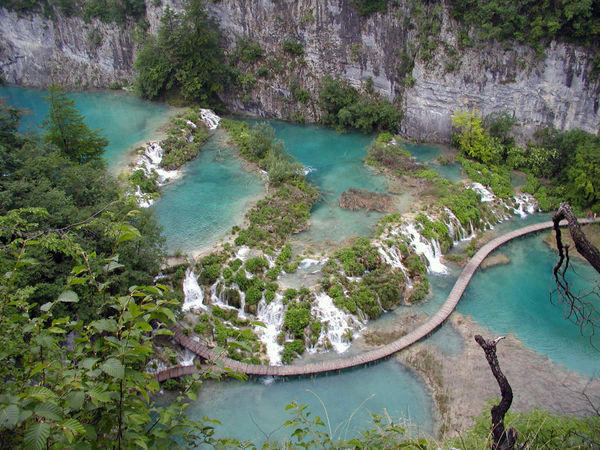Croatia’s Stunning Plitvice Lakes
Between the Croatian coast and its capital city lie the Plitvice Lakes — a watery wonderland few Americans find.
By Rick Steves

In Croatia's rugged interior, a stone's throw from the Bosnian border, hides one of Europe's most exotic hikes: through Plitvice Lakes National Park. There's nothing like this lush valley of 16 terraced lakes, laced together by waterfalls and miles of pleasant lakeside walkways along wooden planks. That this park's unique and stunning beauty isn't universally known is yet another reminder that Europe offers endless thrills beyond its most famous sights.
On my first visit, I began at a viewpoint for a panoramic orientation. Stretching before me was a European Niagara Falls, diced and sprinkled over a heavily forested Grand Canyon. Heading down a steep zigzag path, I left cars and concrete behind, and entered a pristine world of waterfalls, lakes, and trees, populated with Croatian families at play.
The boardwalk trail carries visitors across the middle of a lake for an up-close view of a row of gurgling waterfalls. I followed it past Šupljara Cave, the location of a German "Spaghetti Western" filmed here in the 1960s and still beloved by German tourists today.
Continuing along a path leading to more picturesque cascades, I pondered the strange juxtaposition of Plitvice's overwhelming natural beauty with its wartime misfortunes. On Easter Sunday in 1991, the first shots of Croatia's war of independence from Yugoslavia were fired in this park. The predominantly Serbian Yugoslav army occupied Plitvice and the surrounding region until 1995; most of the Croatians you'll meet here were evacuated and lived near the coast as refugees.
Just a couple decades later, there's not a hint of the recent war and the park is again a popular tourist destination. On a busy day, the park welcomes 15,000 hikers — mostly Croatians and other Europeans, plus in-the-know Americans — seeking Plitvice's charms.
Silent, pollution-free electric boats shuttle hikers across the park's biggest lake. While waiting for the boat, I chatted with the industrious grandmas who sell strudel and wheels of homemade cheese along the lake. Watching these humble yet happy Croatians at work, I felt thankful that the 21st century has brought peace, prosperity, freedom, and stability to this corner of Europe.
At the far side of the lake, more boardwalks lead to the most spectacular stretch of the trail — a wonderland of sleepy trout, Monet greenery, and frisky falls. There are a million ways to catch tiny rainbows in the mist as boardwalks wind around and above the bridal fair of lacy waterfalls. The lazy trout seem to understand that fishing is forbidden — they're huge, plentiful, and oblivious to the many visitors. As I strolled, I watched for the park's fabled wildlife. The park boasts of hosting deer, wolves, wildcats, lynx, wild boar, otters, and more than 160 species of birds (though on this visit, apart from the throngs of trout, I found only mice). Plitvice is also home to highly endangered European brown bears…but they have the good sense to stay far from the hiking paths.
Geologists are fascinated by Plitvice. This fantasy world of lakes separated by natural limestone dams — constantly built up by deposits of calcium carbonate, even as they're eroded by the flow of water — is a perfect storm of unique geological features you'll rarely find elsewhere on earth.
The park limits the number of daily visitors, and it's on most Croatia bus-tour itineraries, so it's wise to book tickets in advance. It's possible to get there by bus (express buses take 2.5 hours from Zagreb and depart several times each day in summer), but is easier by car. Because the park is so well-organized for an efficient visit, most visitors find that a few hours to hike the trails is plenty. If possible, arrive in the evening, spend the night, hike right after breakfast — then move on after lunch. If the park's three hotels feel like they were built for big tour groups during the communist era…it's because they were. To save money and enjoy a more intimate experience, try one of the many sobe (rooms in a private home, like B&Bs) dotting the countryside around the park.
After a few hours of strolling the Plitvice boardwalks, drop by the rustic park restaurant, with its heavy-timber beams and open wood-fired grill, to dine on one of those trout that have been grinning at you all morning. Sit back, review your photos, and marvel that Europe has treats of this scenic caliber that don't even make it onto most American travelers' wish lists.

